Motorcycle owners love to modify and improve their bikes with aftermarket parts, and there is a huge market for devices that will tweak the fuel injection hardware/software.
The purchase of a Fuel Injection modification device is usually based on a more or less well defined wish to “improve” the bike, but it is important to understand what kind of improvements can actually be achieved.
If we go back to the chart from the chapter about mixing air and fuel, it’s clear that the modern fuel injected bike already have plenty of top end power, and the possible improvements in this area is within a few percent.
A few modern bikes have very restricted exhausts or air filters, and you can get more power from the engine by installing aftermarket parts, but this is an improvement made by increasing the air flow through the engine – not a fundamental glitch in the fuel injection ECU programming that is stopping your bike from performing at its best.
But it is also clear that the low speed rideability and throttle control is poor on all standard motorcycles, and there are significant improvements possible in this area, which will make your bike nicer and safer to ride.
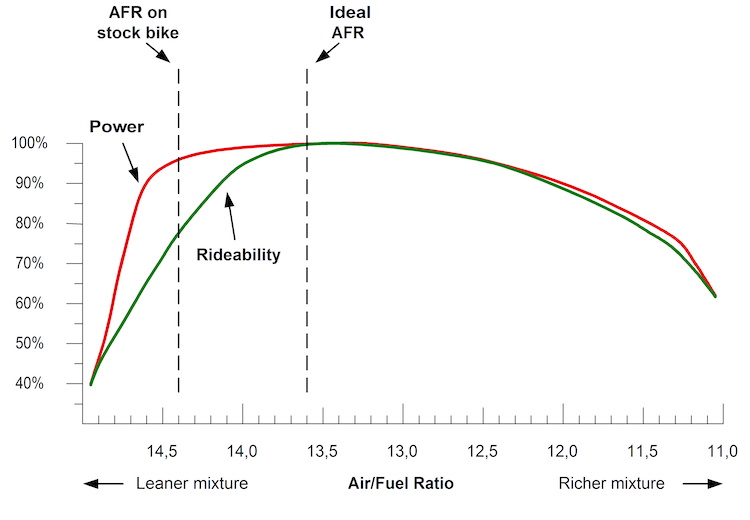
So, the improvements we can expect to see when we tweak the fuel injection correctly is about rideability – not top end power !
You can find loads of products with fantasy claims and fake dyno charts promising you amazing gains in top end power. Forget about it – it is not going to happen. A proper fuel injection modification will make your bike safer, easier, and more rewarding to ride, but it will not increase top end power to any significant degree.
This goes for all modern closed loop fuel injected motorcycles (all bikes from 2006/2007 and newer, but also some earlier bikes). The picture may be slightly different on older “open loop only” fuel injected bikes.
 The rise and fall of the Power Commander.
The head line above may well trouble the common opinion that the Power Commander is the only true solution in the search for the perfect bike.
In this chapter I will stay with the term “Power Commander”, as this is the most common multi-adjustable Fuel Injection modification. But the chapter also covers devices like the Bazzaz, Fuel Pak, etc….
All the multi-adjustable devices require you to remove or bypass the lambda sensor to make the ECU operate in full open loop mode. This means that you no longer have the very good closed loop mode to keep the AFR safe, but you have now taken full responsibility of the AFR, and if you program the device wrong you can destroy your engine, or make it run really poor.
And as you no longer have a closed loop function, you will have to dyno and set up the Power Commander again if you install another exhaust or air filter.
It is often mentioned that the opportunity and freedom to adjust any parameter you can think of is a big advantage with the Power Commander, but this is only true if you or your mechanic is able to get the programming right. I have no reason to doubt the qualifications of your local mechanic, but his chances of outperforming the factory development team is rather slim. And the fuel mapping on a modern motorcycle is actually very good – it’s just running the bike a tad lean overall.
If you have a thousand parameters to adjust, you have a thousand ways of doing things wrong and only one way to do it right - And this is actually the biggest problem with the Power Commander and similar multi adjustable devices.
Most of the Power Commander installations we see are making the bike run way too rich, and are just wasting a lot of fuel and increasing pollution a lot.
Rideabiity are mostly still better than on the stock bike because the engine runs better on too rich mixture than on too lean mixture, but it’s an expensive choice for a solution that is mostly less than perfect.
To be fair to the Power Commander, it should be mentioned that it is often the only solution to improve the early fuel injected motorcycles. Some of the early “open loop only” bikes often had a very poor fuel map resulting in big AFR variations across the map. This can not be solved by simpler solutions, but the Power Commander can be adjusted to correct the fuel map.
If you are changing the basic engine configuration (Bore, stroke, cams, valves, pressurized charging, etc., you will probably also need the Power Commander. This is way to far from the standard engine setup to be solved by simpler solutions.
In the chart below you can see how the Power Commander works.
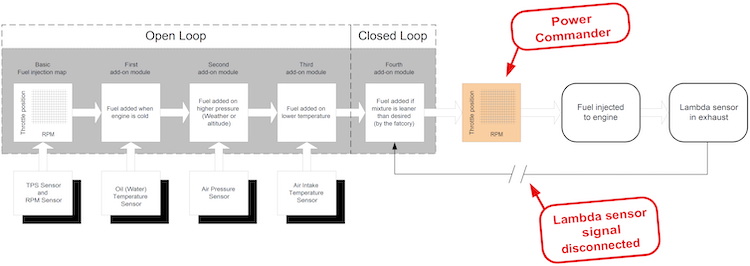 - You will see that the multi adjustable Power Commander sits between the bikes own fuel injection ECU and the injector nozzles and will allow you to change the fuel injector signal any way you like.
- The lambda sensor is disconnected and there is no longer any kind of AFR adjustments done in closed loop mode.
- You have full control AND full responsibility of the result.
 Lambda sensor tweaks
There are plenty of devices available that is tweaking lambda sensor signal. They are usually cheap and easy to install, so many people are tempted to give them a try, but it is a poor solution that should be avoided.
There are several reasons to stay away from lambda sensor tweaks: - This is a closed loop operation tweak, and it will give your engine the richer mixture where it is needed the least.
- So you are mostly just increasing fuel consumption and pollution a lot without significant rideability improvements.
- You are not really in control of the process because the lambda sensor signal can not be tweaked to make the engine run at the AFR we want – The device will just make the bike run as rich as the ECU software allows.
- There is no longer a closed loop feedback regulation to adjust AFR for different exhausts and filters.
The chart on the effective range of the lambda sensor clearly shows that it can never be tweaked to the AFR we want for the best rideability (Usually around 13,6:1). Simply because the lambda sensor will have no idea what is going on when the mixture gets richer than aprox. 14,1:1.

It does not matter much if you just remove the lambda sensor, or install a lambda eliminator dongle, or an adjustable device – the lambda sensor can still not be tweaked beyond it’s physical abilities!
The common picture for all lambda sensor tweaks is that they will make the AFR richer by an unknown percentage in the area where you need it the least. So they will just make your bike waste a lot of fuel and increase pollution.
Here’s a description of the different lambda sensor tweak methods.
 Lambda sensor removal
This is the simple DIY approach lambda sensor connector where the lambda sensor connector is just unplugged.
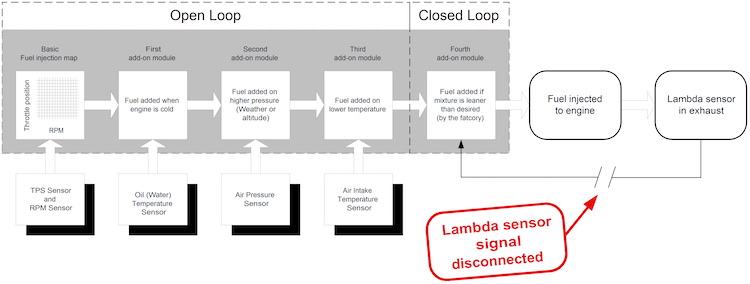 - The ECU will receive no signal from the lambda sensor = a 0 volt signal.
- So the ECU will believe the AFR is too lean and add more fuel.
- But this will not change the AFR (because there is still no signal), and the ECU will add more fuel in an attempt to correct the AFR.
- This process will continue until the mixture is as rich as the ECU software allows.
 Lambda sensor eliminator dongle
This is a simple dongle (Connector with no wires) that you just plug into the cable connector that is normally attached to the lambda sensor.
You can find plenty of these in various webshops, and they often come with fairy tale like promises of improvements – I’ve even seen them advertised as fuel savers :-)
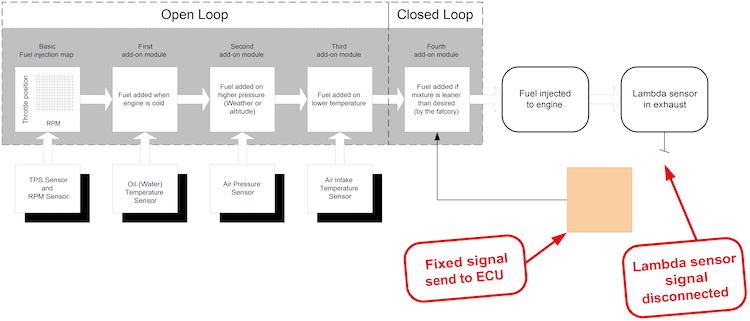 - You’ll see that it’s a slightly different setup than just disconnection the lambda sensor, but it’s not better in any way.
- Most of them are only a resistor that will let the heater circuit pull enough power so the ECU does not flash a warning in the dashboard for “faulty lambda sensor heater circuit”. The actual lambda sensor signal to the ECU is still just disconnected.
- A few of them is adding a resistor to fix the lambda sensor input voltage, and this way you can adjust the sensor signal to make the ECU believe the AFR is at a certain level.
- But you are still restricted by the lambda sensor’s effective range, so there is no way you can adjust the AFR to a desired level by using the dongle.

The adjustable Lambda sensor tweaking device
The adjustable lambda sensor tweaker is not disconnecting the Lambda sensor signal, but sits between the lambda sensor and the ECU and will try to adjust the lambda sensor signal to make ECU change the AFR to a more desirable level.
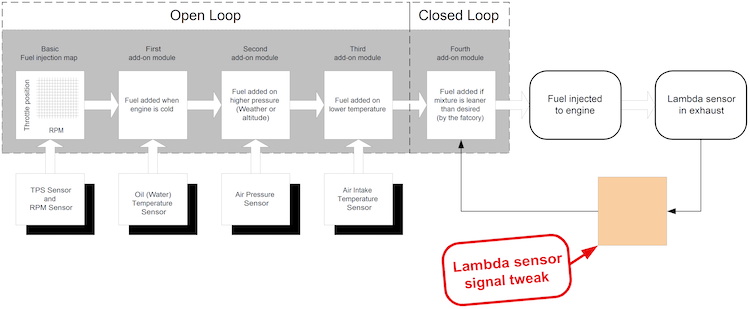 - The theory is that it is possible to make the lambda sensor regulate the AFR outside it’s effective range, but you would never be able to obtain a stable signal.
- We are usually aiming for an AFR around 13,6:1 for best rideability, and if you look at the “lambda sensor effective range chart” you will see that we are now in an area where the lambda sensor signal will be very (VERY) close to 1,0 Volt.
- A 1,0 volt signal is a low range and a low voltage signal. It is very sensitive and easy to disturb, and even a 0,05 volt variation would change the AFR a lot.
- This part of the lambda sensor output curve is varying a lot with the sensor temperature, so even if you could adjust the AFR to the desired level in laboratory conditions, you would see a completely different result when you took the bike on the road.
- It is not without reason that the lambda sensor have an “Effective Range”, and trying to make the sensor work outside the physical limits is doomed.
- And even if you found a magic trick to make this setup work, you would still get the fuel enrichment where you don’t really need it !
You may remember my recommendation NOT to tweak or remove the lambda sensor – now you know why :-)

The BoosterPlug
Already in the introduction chapter, I mentioned that I am the inventor of the BoosterPlug, so I am obviously not unbiased. But I’m convinced that the BoosterPlug is by far the best solution for most bikes, and my claim is backed up by way over 100.000 happy customers world wide, so it’s probably not too bad !
Feel free to decide for yourself if this is just slick high-pitched sales talk or if there may be something to it… |
Tweaking the air temperature sensor signal can be a very good solution provided it’s done correctly.
The idea is to change the air temperature sensor signal to make the ECU believe the air is a bit colder than the actual outside temperature, and the ECU will respond by making the AFR slightly richer. And as the Lambda sensor signal is not interrupted, your bike will only get the richer mixture when needed to improve rideability, as the lambda sensor will adjust the mixture back to the leaner setting on the open roads to save fuel and keep emissions low.
This simple lift of the entire open loop programming can only be successful if the basic fuel map in the ECU is reasonably accurate. If the ECU fuel mapping is resulting in very different AFR across the map, there is no easy plug and play solution.
All bikes from 2006/2007 are running under very strict emission regulations and WILL have excellent base maps – otherwise they would never have been approved for road use.
For bikes before 2006/2007 the picture is different. Some motorcycle brands got the mapping right early, where other was pretty horrible until they had to improve to get the bikes approved for road use. This is why we do not offer the BoosterPlug for all models older than 2006.
Tweaking the air temperature sensor signal correctly is not as easy as it seems, because the air temperature sensor is not a linear output device. This means that if you just add a fixed resistor to the temperature sensor signal line, you could reach a solution that could perform well in 20C, but would not work properly in 15C or 25C.
The BoosterPlug comes with it’s own temperature sensor and is set up to make the original air temperature sensor and the BoosterPlug sensor work in cooperation to provide an output that is correct and stable in all ambient temperatures. It sounds simple, but it will only work if you have sufficient knowledge on engines and electronics. There’s a lot of hidden engineering in making things simple and good !
In the chart below you can se how the BoosterPlug is installed between the air temperature sensor and the ECU, and that the lambda sensor signal is left undisturbed.
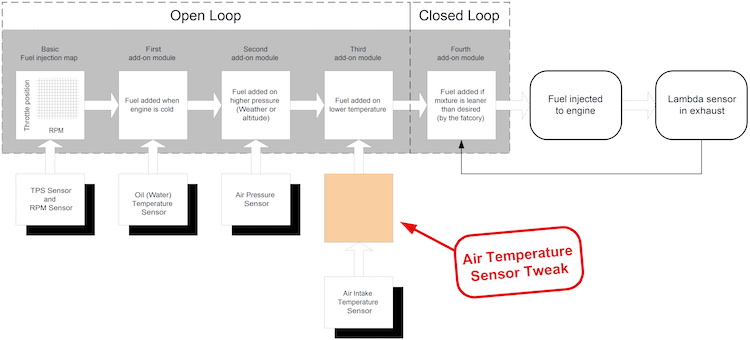
Here’s why the BoosterPlug is the better solution:
- The BoosterPlug will only provide the slightly richer AFR when needed (Open loop mode) to improve overall rideability and make the bike easier and safer to handle.
- As soon as you ride at a constant speed on the open roads, the bike will be able to retain closed loop mode because the lambda sensor is kept active. This is keeping fuel consumption and emissions low, so the BoosterPlug will give you the best of both worlds.
- As the BoosterPlug works in cooperation with the lambda sensor, you can swap exhausts and air filters as you like without risking expensive and dangerous engine breakdowns.
 | |





